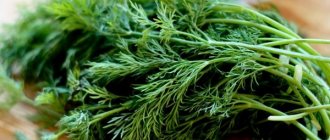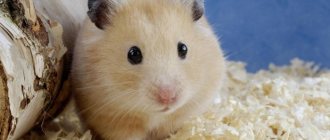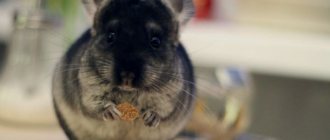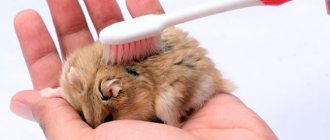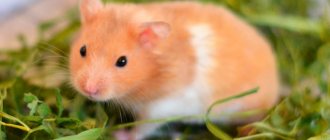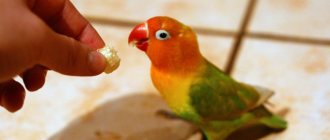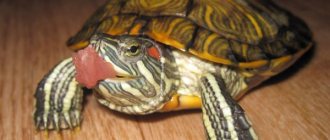- home
- Nutrition
19.03.2018
Having decided to purchase a hamster, inexperienced owners are faced with a number of questions. First of all, you need to find out how many times a day to feed your hamster. Despite the apparent obviousness of the answer, difficulties may arise. The smaller the animal, the more careful treatment it will require.
It is very important to feed your Djungarian hamster properly. After all, healthy nutrition and digestion are the key to the long life of this small animal, which is why it is important to take into account the feeding regime.
How many times a day should you feed a hamster?
Inexperienced owners often wonder how many times a day they should feed their hamster. If everything is relatively clear with cats and dogs, then here we are talking about how to organize the nutrition of a rodent that is prone to making hiding places and supplies.
Healthy digestion is the basis of longevity for these animals, so attention should be paid not only to the composition of the diet, but also to the organization of the feeding regime. Hamsters are nocturnal and sleep almost all the time during the day. This feature must be taken into account to decide how many times you can feed your hamster.
Peculiar look
At first glance, it is clear that this is not the forest fluffy beauty that we are used to seeing in pictures. But they resemble them in the shape of their head and curved back. The Chilean degu squirrel is usually gray or brown, but these animals can also be red. On the back the hair is longer and coarser. The abdomen is usually lighter - from cream to milky in color.
The main difference from an ordinary squirrel is that this animal does not have a luxurious tail. In degus it is covered with skin, which, with a sharp tug, is removed with a stocking. After this, new skin grows on the base. Adult individuals weigh 300-400 g. Their length is approximately 40 cm including the tail. Domestic pets usually weigh and grow slightly less than their wild counterparts.
The digestion of these animals is quite sensitive, so you need to consult with the breeder and choose the food for degu that he recommends. We'll talk about this in more detail below. The squirrel's vision is not very sharp, but the eyes are located in such a way that they can provide a wide range of vision. The animal has excellent hearing and sense of smell, so it quickly and easily navigates. Moreover, regardless of the time of day and lighting. The animals live quite a long time. In nature, this period is limited to 6-8 years, and at home they often live up to 12 years.
Feeding frequency
It's funny to watch the animal eat, but the optimal time is to feed once in the evening when the animal is active. Another acceptable option is feeding in the evening and early morning hours, before the animal naps during the day. The evening portion should be significantly larger than the morning portion.
Having decided on a schedule that is convenient for themselves, it is better for the owner to stick to one feeding time. With amazing accuracy, the animal will wait for dinner at the appointed time. This stability is beneficial for the rodent's digestion.
Due to the high metabolic rate, the hamster cannot tolerate hunger strike at all. It is difficult to answer unequivocally how many times a day a hamster should eat.
Although the main meal occurs at night, the animals like to wake up during the day to have a snack. Therefore, access to food should be available almost around the clock.
When it comes to how often you should feed your hamster, it is important not to overdo it. You cannot give food more than twice a day: this will disturb the animal’s sleep. Juicy and protein foods can spoil if the hamster does not eat it right away. For the same reason, inventories are regularly inspected, removing spoiled products.
Feeding hamster mother and babies
The diet of a hamster and her babies differs from the usual diet of a healthy hamster. An adult hamster needs enough nutrients to live an active lifestyle without gaining excess weight. And the hamster grows, develops and must move a lot, play with brothers and sisters - all this requires much more energy than an adult animal.
The same applies to a nursing mother: it is difficult to feed a dozen babies, and even with increased nutrition, she loses weight by 25% in 4 weeks of feeding the young.
Important: for normal development, hamsters must receive plenty of animal protein and calcium for 1 month. Given the high calorie content, this feeding scheme is naturally no longer used for hamsters older than 6 weeks
Vegetables fruits
A pregnant and then nursing mother and her babies should not eat fruits and vegetables, which can cause inflammation of the intestines - ascites. You can leave only carrots, zucchini, pumpkin. Apples are strictly forbidden until 1.5 months. At the same time, only those products are reliable that are grown away from roads, ideally in your own country house or home.
Greenery
The diet also includes greens - sprouts of oats, wheat, peas, a small amount of dill, parsley. Leaf lettuce can absorb toxic and harmful substances, so it is safe to eat one grown in your own garden rather than bought in a store.
If “pure” vegetables are not available, you can replace them with vegetable carrots, pumpkin purees without sugar, starch, salt, or additives.
Water
A nursing mother needs clean and fresh water, which she drinks a lot for lactation.
A working drinking bowl (hanging) in a cage is an important condition
Calcium-containing foods
Hamsters require calcium for skeletal development, but food containing only calcium is not sufficient to supply it to the body. Calcium is not absorbed without vitamin D and phosphorus, so you need to give low-fat cottage cheese once every ten days, herbal rings with calcium every day, and a boiled egg once a week.
Protein food
Every day, children and mother should receive food containing animal protein - hamsters need it for normal development, and mothers need it for lactation. This could be baby meat puree (without salt, sugar, spices, soy, or prohibited vegetables). The base of the puree is chicken, because... other meats are difficult for the body to digest. You also need to give a boiled (chicken or quail) egg, boiled chicken breast without spices and salt.
Porridge
Since hamsters cannot drink milk at any age, cereals should be strictly dairy-free. At the age of up to 6 weeks, hamsters need to be fed with baby porridge, especially for babies who are developmentally delayed and nursing mothers who are exhausted from feeding their offspring. These can be hypoallergenic baby cereals - not rice, not corn, without milk, sugar, gluten, flavorings, oatmeal and buckwheat are best.
Main food
Basic dry staple foods should be included in the diet daily, and in much larger quantities than for adult hamsters. Be careful with the content of oats in the feed: it needs to be removed, because... blind babies can injure their cheek pouches.
The best food for hamsters up to 3 weeks is imported food with small grains, for example, Padovan Crisety Grandmix. Dry Hercules can be mixed into the food (half and half).
Herbal granules
The main food contains grass pellets and rings, which hamsters eat not dry, but soaked. They are good for digestion and contain vitamins and microelements.
Like adult hamsters, young ones especially should not eat fatty, sweet, salty, spicy, fried, floury foods and everything from the list of prohibited foods.
Amount of food
How much food a hamster needs per day depends on many factors:
The average rodent eats an amount of food per day equal to 70% of its body weight.
A Syrian hamster weighing 140-150 g should receive about 100 g of food.
Such accuracy of calculations is not used in practice, and the owner can only approximately say how much a hamster eats per day.
The Djungarian hamster or Campbell is so small that it seems to the owners that they are eating “closely.”
It is a big mistake to overfeed your pet. Hamsters get fat easily.
From the outside it may look cute, but the animal itself faces serious health problems and shortens its life. If a dwarf has already received a tablespoon of dry food, and the feeder is instantly empty, you should not fill it again. The pet simply hid food around the cage.
Ensuring activity
Keeping hamsters in tiny cages or a three-liter jar is cruel to the animal, which in nature runs several kilometers every day. It’s not for nothing that their home is equipped with a running wheel. Caring for hamsters may include providing them with leisure time. The owners set up entire playgrounds, labyrinths and tunnels for curious rodents.
Despite the need for movement and variety, you can only let your pet out for a walk around the apartment in a walking ball. Otherwise, the hamster at home is in mortal danger - it can get stuck, be crushed/pinched by a door, fall, fall into a pan, eat a poisonous plant, or chew through an electric wire. Catching a pet can be very difficult.
You cannot organize a walk on high surfaces (table, sofa). All hamsters come from the lowland steppes; they do not understand and are not afraid of heights. There is a high risk that the pet will fall.
Is it possible to walk a hamster outside?
With the best of intentions, some owners strive to let their pet spend time in nature. But the pet hamster will not receive pleasure from such a walk, but extreme stress. Not many people think about the fact that a pet can become seriously ill.
In nature, the animal is in wait for predators: dogs, cats, rats, crows. A nimble baby can easily run away and get lost forever. The outdoor environment is more aggressive and unstable: the hamster can become hypothermic, especially if the grass is wet, or overheat in the sun. The soil and grass are often infested with parasites and are a source of infection due to wild rodents.
How to properly prepare a diet for a hamster
Only for registered users
Proper nutrition is important not only for humans. Your pet must receive all the necessary nutrients - this is the only way to avoid health problems for your hamster.
When compiling a diet, be sure to take into account the following points:
To better understand the principle of selecting healthy food and diet, it is useful to study the habits of rodents in the wild. These animals drink little liquid and always stock up on food.
The hamster is fed twice a day, with the main portion given in the evening. If a hamster tries to bury food in a secluded part of the cage, he should not be allowed to do this. Feed can spoil and cause various diseases. It is better to reduce the amount of food. The diet must be balanced and of high quality. It is best to buy food in specialized stores.
Nutrition for elderly and sick hamsters
Animals that are sick or are already quite old (elderly) are characterized by a decrease in their activity and appetite. Therefore, the owner needs to rebuild the animal’s diet and feeding regime.
- Food should be predominantly chopped and grated. also give porridge with water or pureed vegetables without salt and sugar with added vitamins.
- To prevent intestinal disorders, your pet must be given grain food.
ATTENTION. The animal should be provided with plenty of fluids to prevent dehydration. As a drink, you can prepare a chamomile decoction or regular drinking water, but exclude honey and milk
Do's and don'ts for hamsters
The best diet for rodents is a grain mixture and green food - this is what they eat in nature.
Suitable grains include wheat, oats, and corn. You can feed hamsters watermelon, pumpkin, sunflower seeds, beans, and peas. Not often, but you can give walnuts, pine nuts, cashews, and peanuts. Leaves of plantain, dandelion, and clover are suitable as green food. Rodents like beetroot, carrot tops, and lettuce leaves. In winter, hamsters are fed grass hay. Branches of linden, maple, willow, apple, pear, birch, as well as branches of shrubs (rose hips, raspberries, black currants) are ideal for grinding teeth. Leaves and branches should be collected away from roads; it is best to do this during trips to nature.
You can add fruits and vegetables to your hamsters' diet. Pieces of dried apples, pears, and various berries are a treat for rodents. They also love carrots, beets, zucchini, cucumbers, pumpkin, and potatoes. In fresh form, you can feed pieces of banana, apricot, pears, and peaches.
The diet of domestic hamsters should contain protein products in small quantities. It is recommended to give rodents a little cottage cheese, a boiled egg, milk, and once a week a small piece of boiled meat. Many hamsters like small insects - ants, worms, grasshoppers, beetles, locusts. It is best to buy such “live” food in pet stores. You should also give your hamster vitamins and mineral supplements (drops, tablets...), they are mixed with fresh food.
Source
Nutrition of Djungarian hamsters
This variety of domestic rodents, such as Djungarian hamsters, has become very popular among breeders because they are not only attractive in appearance, but also unpretentious. However, breeders should also know the peculiarities of feeding such animals.
- The basis of the diet of this rodent, like others, is dry food. It is recommended to purchase several different ready-made mixtures at a pet store to balance the supply of all necessary minerals and vitamins.
- Preference should be given to cereals such as buckwheat (raw and cooked), wheat (especially sprouted), oats or oat flakes, barley, pearl barley, lentils, peas, chickpeas. Minimize rice and millet in your diet.
- Raw or oven-dried sunflower seeds without salt.
- You can give milk or cheese to animals, but not more than once a week, and choose high-quality products with a minimum fat content.
- Food rich in protein is also necessary for Djungarians, and the meat should be of a lean variety (beef, chicken) . Meat and offal should be boiled without salt and spices. You can also give your pet 1/3-1/2 of a boiled egg.
- It is better to exclude fresh bread, but a small cracker once a week is allowed.
- to pamper your hamster with nuts, berries, fruits (exclude exotic ones and remove the seeds) and dried fruits , but do not overfeed them in small quantities, since a large amount of sugar in fruits can cause diabetes.
- Vegetables should also be present in the animal’s diet - cucumbers, radishes, bell peppers, cabbage, carrots, zucchini and others. It is also recommended to give various greens, such as parsley, dill, lettuce or spinach.
REFERENCE. Rodents love to chew on tree branches, and these should be young branches of fruit crops. Coniferous species are excluded, since their resin is dangerous to the health of animals.
Djungarian hamsters will only need two main meals - in the evening and early in the morning. At the same time, food must be present in the cage around the clock - it is necessary for daytime snacks.
How often should you feed your hamster at home?
A caring owner is always concerned about improving the living conditions of his pet. An important aspect of caring for a hamster is feeding. Inexperienced rodent owners are interested in how many times a day to feed a hamster so that the pet feels cheerful, stays healthy and cheerful.
Proper, nutritious nutrition is an important element that contributes to the longevity of an animal. Diet is as important as the foods that make up the animal’s diet. Read more about the list of prohibited and permitted products to avoid health problems for your pet.
Hamsters are most active at night. During the day, rodents prefer to sleep or rest. When thinking about how often to feed a hamster, you should take into account the rhythm of the animal’s life.
Feeding frequency
The best option is to feed once a day when the animal is active - in the evening. Two meals a day are also allowed - morning and evening. In the evening, the portion of food should be significantly larger than in the morning, since the pet consumes more calories at night.
Having drawn up a feeding schedule for the animal, it is recommended to adhere to this schedule. The pet will expect food at the “appointed” time. Making a schedule is good for the animal's digestive system.
Babies' metabolism is quite fast, so starvation should not be allowed. It is difficult to say how many times a day to feed a hamster. During the day, animals like to snack, despite a hearty dinner. It is recommended to monitor your pet's food availability throughout the day. Be sure to always have water in the drinking bowl.
Do not feed too often. This will lead to sleep disturbances and health problems. Perishable foods should be removed immediately after your pet eats. Regularly monitor and remove food debris. Make sure that the homa does not stock up on vegetables. Food can spoil and if the animal accidentally eats something from the cache, poisoning may occur.
Common feeding mistakes
To avoid health problems, you need to feed your hamster properly. Often, inexperienced owners violate nutritional rules and put their pet at risk:
- Eating too often. This leads to weight gain. Obesity causes digestive disorders, blockage of blood vessels, cardiac arrest and various dangerous diseases. That is, excess weight shortens the already short life span of rodents.
- Large portions of food. This will also lead to weight gain and the development of many diseases.
- Insufficient or irrational nutrition. A hunger strike is dangerous for a rodent, as its body suffers from a lack of nutrients, which increases the risk of various diseases. It is important to provide the animal with high-quality dry food, and to use vegetables, herbs, fruits, and protein foods for feeding.
- Feeding your pet stale or spoiled food. It is necessary to regularly remove spoiled food from the feeder. If a hamster eats spoiled or moldy food, it risks poisoning and other digestive disorders.
- Introduction of forbidden foods into the diet. You should not feed your hamster fatty, starchy, or too sweet foods.
- Irregular cleaning of the feeder. You should feed your hamster only from clean dishes. After the meal, you need to remove any leftover food and wash the container.
Feeding your hamster correctly means creating a diet of healthy and varied foods, following a meal schedule and controlling food portions. The set of rules is supplemented by regular cleaning of the cage after eating and washing the feeder. In this case, the pet will be healthy and active.
Amount of food
How much a hamster eats per day depends on several factors:
According to statistics, a hamster eats a volume of food per day equal to 70% of its body weight. For example, a Syrian weighing about 150 g should be fed 100 g of food.
As a rule, owners do not make accurate calculations, guided by observations of the pet. Don't feed your Djungarian hamster too much. Overfeeding will lead to obesity and health problems.
It’s funny to look at a fluffy, plump dwarf, but the animal is very uncomfortable with excess weight. Obesity threatens serious diseases and shortens the life of a hamster. Keep an eye on your pet while eating; he may not eat the amount of food intended for him, but may hide some of it.
Inventing entertainment
Of course, the hamster always has a lot to do in his cage, but sometimes he needs some extra entertainment. You can buy him toys or make him a real amusement park that you can use while walking.
Prepare:
- several toilet paper tubes and paper towels;
- empty plastic bottles;
- empty cardboard boxes of different sizes;
- cardboard;
- cardboard scissors or linoleum knife.
How to build an amusement park?
First, think about what it will look like. Lay out all the materials on the floor or make a sketch. Now start assembling.
Make a slit in the center of one of the pipes. Connect some of the pipes to each other, and insert some into boxes. Cut round holes in the top of some of the tubes. They are needed so that the hamster can stick out of the holes. Close the system of pipes and boxes to each other.
Make sure that there is enough space in the pipes for the animal - otherwise it will not fit there.
Don't forget about safety!
- Look for boxes that are missing writing or graphics. The animal will probably gnaw on them, and the paint may give you a stomach ache.
- Do not use glue or tape. They can stain fur and are very dangerous if ingested.
- If you don't want to bother with cardboard, assemble the entire structure from plastic. Sections of sewer pipes are excellent for this purpose. They are easy to attach to each other. Show your imagination, and your pet will definitely thank you.
For the convenience of walking your hamster outside, you can purchase a hamster leash.
How many times a day should you feed a hamster?
Many hamster owners love them for the way they plump up their cheeks while feeding. This is a nice habit, but first of all you need to think about your pet’s health and not allow him to eat 3-5 times a day. This threatens weight gain and digestive disorders. Therefore, every rodent owner should know how many times a day to feed a hamster.
By nature, these rodents are nocturnal animals; they sleep most of the day. In the evening, the animals wake up to replenish their energy reserves with food and go about their business. Therefore, 2 feeding options are suitable for them:
For feeding, you need to choose a time when the animal is active or not yet sleeping. Moreover, in the evening he should eat a larger portion of food than in the morning.
To understand how many times a day a hamster should be fed, you need to watch its schedule. Then the rodent owner will be able to determine the most appropriate frequency of meals. This schedule must be followed so that the animal’s digestive system does not fail. Within a week he will get used to the routine and will wait for dinner or breakfast at the right time.
Important! Hamsters have a fast metabolism, so they cannot go without food for a long time. The owner can feed the animal 1-2 times a day, but should not forget about snacks that will help him wait painlessly for the next meal. It is important to ensure that your pet always has access to food and clean water.
But you should not feed your hamster more than 2 times a day. This will lead to rapid weight gain, digestive disorders, sleep disturbances and other health problems. You need to regularly remove leftover food after meals. If the hamster stores up perishable foods, then poisoning is guaranteed after consuming them.
Future owners of rodents are interested in how many times a day they need to feed Djungarians or Syrians. They believe that the frequency of meals depends on the size of the hamster, because, as you know, the former are smaller than the latter. They mistakenly assume that Djungarians are fed less often than Syrians. But this indicator depends only on the feeding schedule of the animals, and not on their size.
Basic rules to consider when caring for hamsters
There are a number of rules that need to be taken into account when caring for hamsters. They are the following:
The hamster is a solitary creature
It is very important that he lives separately. If you add another hamster to a hamster, they will fight. And in some cases they can even kill each other. The hamster's cage should be spacious enough
Its dimensions should be fifty by thirty centimeters. The number of floors can be any. The hamster should be able to run a lot. Creatures living in nature are accustomed to increased activity. They move around a lot. Running is in their blood. Accordingly, we recommend purchasing a special wheel for your hamster. It should be large enough in size. To make it convenient for the creature to run. We also recommend buying him a ball. It will be useful for the hamster to walk around the apartment. You need to breed hamsters very carefully. Otherwise, you risk causing the creatures to fight if you put them in the same cell. After the hamster gives birth, its offspring will need to be housed. They must be placed in a separate cage. This is quite an expensive endeavor. Because you have to buy a lot of cells
And in some cases they can even kill each other. The hamster's cage should be spacious enough. Its dimensions should be fifty by thirty centimeters. The number of floors can be any. The hamster should be able to run a lot. Creatures living in nature are accustomed to increased activity. They move around a lot. Running is in their blood. Accordingly, we recommend purchasing a special wheel for your hamster. It should be large enough in size. To make it convenient for the creature to run. We also recommend buying him a ball. It will be useful for the hamster to walk around the apartment. You need to breed hamsters very carefully. Otherwise, you risk causing the creatures to fight if you put them in the same cell. After the hamster gives birth, its offspring will need to be housed. They must be placed in a separate cage. This is quite an expensive endeavor. Because you have to purchase a lot of cells.
How to keep a hamster cage?
It is imperative to place filler in the cage. It can be made in the form of granules. Or maybe corn. In addition, the cage must have:
- Napkins. They must be paper. And also white and odorless.
- Drawing for a nest.
- Wheel.
- Special drinking bowl. It must be suspended.
- A bowl. It is recommended to place special dry food in it.
Other items can be placed if you need them. For example, we are talking about a house. Special toilet. And so on.
Where should the cage be?
The cage cannot be placed randomly. It should stand according to the following principle:
- It cannot be placed in the kitchen.
- It cannot be installed in the corridor.
- It cannot be installed on a balcony.
- It should be placed at a large distance from the windows. And also from the doors.
- It should be placed at a distance of at least two meters from the batteries.
Keep in mind that hamsters are very fragile creatures. They can get sick from the slightest breath of wind. Accordingly, they need to be placed in the most favorable part of the room. Then they will be safe.
The cage must be placed in a quiet place. Keep in mind that hamsters have very sensitive hearing. Because of this, they get nervous when they hear something loud.
Keep in mind that sharp sounds provoke stress in hamsters. This has the effect of reducing the creature's lifespan. During the daytime, hamsters are in a state of sleep. And your task is not to wake them up.
The cage must be kept in a place that is ventilated
At the same time, it should not be placed in a draft. Be sure to place a specialized thermometer next to the cage. With it, you have to monitor whether the temperature in the room is optimal.
For example, hamsters should be kept in a temperature range of twenty-two to twenty-eight degrees. Not lower and not higher. In the first case, the hamster will freeze. In the second, it will overheat.
Amount of food
The second important issue in feeding a hamster is determining the portion of food. This indicator depends on the following factors:
Interesting! The daily portion of food fed to a rodent should not exceed 70% of its weight. For example, the Syrian hamster's body weight ranges from 100 to 150 g, so it eats about 100 g of food per day. The Djungarian hamster needs to be fed less food, since its weight does not exceed 50 g. Representatives of this breed need 20–30 g of food per day.
To determine the daily portion of food, it is enough to observe your pet for 2–4 days. If you feed hamsters more than 2 times a day or intentionally increase food portions, they will rapidly gain weight. A fat rodent looks cute, but it is not at all comfortable with such body weight, and the risk of disease increases.
The basis of a hamster's diet is dry food. These can be ready-made mixtures or homemade cereals. The pet can be fed wheat, oats, barley, buckwheat. But millet and rice in the menu need to be minimized. Hamsters love seeds and nuts.
About once a week, rodents are fed low-fat protein foods (milk, cottage cheese, lean meat). Products must be natural and fresh. You can treat your pet to ½ boiled egg (but preferably white) per day.
As a snack, hamsters are given vegetables (cucumbers, radishes, paprika, carrots), greens (lettuce, cilantro, parsley), herbs (alfalfa, dandelion, knotweed), unsweetened seedless fruits (apples, apricots, peaches) and dried fruits. But portions of such food should be minimal.
Pets should not be fed fatty foods, citrus fruits, mushrooms, flour products (except bread croutons), smoked meats, honey, confectionery, potatoes, cabbage. Any food that contains a lot of chemical additives (flavors, preservatives, dyes) is dangerous for the animal.
Sometimes a female hamster refuses to feed her offspring or is unable to do so. Then the owner must do it. In the first week, babies eat only infant formula at intervals of 3 hours and 2 times at night. At 2–3 weeks, their diet is supplemented with grated vegetables, fruits, crushed porridge with water, and the volume of the mixture must be reduced. A month after birth, the hamsters switch to adult food.
A pregnant female needs to increase the amount of protein and calcium in her diet. She is fed greens, sprouted cereals, and increases the amount of cottage cheese and boiled meat. You can give beaten eggs, hard cheese (unsalted), and dairy products. She will happily chew on chalk, coal, phytin or calcium gluconate tablets. The daily portion of food is increased by 1/3, and in the last days of pregnancy - by 2 times. The expectant mother needs more liquid, vegetables, herbs, and greens.
In elderly and sick hamsters, their appetite decreases, so it is enough to feed them once a day. They benefit from porridge with water, vegetable purees without salt and sugar, grain feed, and vitamins.
Nutrition for small hamsters
In cases where a hamster gives birth to babies or very small hamsters were purchased, the owner has the question of how and what to feed such babies.
If hamsters live with their mother, then she feeds them for up to 1-1.5 months. However, if the female refuses to feed the babies or for some reason cannot do so, then the owner will have to feed the hamsters.
- First week. Newborns are fed regular infant formula via a syringe (without a needle) or dropper every three hours a day and twice at night.
- Second or third weeks. Hamsters can gradually add finely grated vegetables, fruits and food, as well as boiled porridge . In this case, you should gradually reduce the amount of infant formula.
- Fourth week. From this point on, small rodents are already able to feed on their own without any restrictions in the diet, so you can finish feeding with infant formula .
Have you ever had to supplement feeding newborn rodents?
How often should you feed your hamster?
Inexperienced owners often wonder how many times a day they should feed their hamster. If everything is relatively clear with cats and dogs, then here we are talking about how to organize the nutrition of a rodent that is prone to making hiding places and supplies.
Healthy digestion is the basis of longevity for these animals, so attention should be paid not only to the composition of the diet, but also to the organization of the feeding regime. Hamsters are nocturnal and sleep almost all the time during the day. This feature must be taken into account to decide how many times you can feed your hamster.
Setting up your home
After purchasing a cage, you need to furnish it properly. At home, rodents need a comfortable place to sleep and an area for active daytime rest. With a sedentary lifestyle, the pet quickly gets fat, and excess weight negatively affects its health. The cell must contain the following objects:
- shelter;
- wheel;
- special stairs or a network of tunnels;
- drinking bowl and food bowl;
- mineral stone;
- wash basins filled with sand.
Litter
The floor of the cage or terrarium must be lined with soft sawdust. In this case, you need to monitor the pet’s condition for the first time. A dwarf may develop an allergic reaction to the litter.
The sawdust should lie in an even layer up to 2 cm thick. Rodents will carry a small part of the floor litter into the house to build a place to sleep. The sawdust needs to be changed weekly to keep the animal healthy. The well-being of your pet will depend on the cleanliness of your home. In addition, stale litter emits an unpleasant odor that is difficult to get rid of.
Instead of sawdust, you can use pieces of torn paper. It should be remembered that it absorbs odors less well and takes a long time to dry. It is not recommended to use glossy magazines or newspaper as bedding. They are impregnated with ink that is toxic to the hamster. It is recommended to tear toilet paper or soft tissues.
Hamsters are given only boiled water
House
Plastic houses are sold in stores, but purchasing them is not recommended. Hamsters constantly sharpen their teeth, so a dwarf can get poisoned or chew through its home. For this reason, it is not recommended to purchase a wooden home. Natural material absorbs urine and secretions well, so it will smell bad. High humidity can trigger the development of the disease. The most suitable option is a ceramic house. The rodent will not be able to move or damage it.
Drinker and food bowls
If a drinking bowl and food bowl are not included with the cage, you should purchase special containers. They are attached to rods. If you place the container on the floor, the hamster will easily turn it over. Increased humidity in the cage will lead to mold growth. Only boiled water should be poured into the drinking bowl. Tap liquid is highly hard and therefore often causes digestive upset in hamsters.
It is better to take food bowls from ceramics. Hard material will prevent them from being chewed or turned over. It is recommended to purchase 2 copies at once: for dry and fresh food. The drinking bowl and bowl should be cleaned with plain water without using soap or other household products.
Wheel
The wheel will allow hamsters to pass the time and maintain good physical shape. While running, skeletal muscles are strengthened. It is recommended to purchase a wheel without bars made of dense solid material so that the rodent's paws do not break when caught between the bars. Zoologists advise purchasing a metal product and regularly lubricating it with oil.
Additional accessories
The hamster washes itself daily. Djungarians usually do not use water for this. They prefer to wash themselves in the sand. For this reason, special sand baths should be placed in the cage. They won't be able to move them or scatter them.
Taming hamsters through treats
Feeding frequency
It's funny to watch the animal eat, but the optimal time is to feed once in the evening when the animal is active. Another acceptable option is feeding in the evening and early morning hours, before the animal naps during the day. The evening portion should be significantly larger than the morning portion.
Having decided on a schedule that is convenient for themselves, it is better for the owner to stick to one feeding time. With amazing accuracy, the animal will wait for dinner at the appointed time. This stability is beneficial for the rodent's digestion.
Due to the high metabolic rate, the hamster cannot tolerate hunger strike at all. It is difficult to answer unequivocally how many times a day a hamster should eat.
Although the main meal occurs at night, the animals like to wake up during the day to have a snack. Therefore, access to food should be available almost around the clock.
When it comes to how often you should feed your hamster, it is important not to overdo it. You cannot give food more than twice a day: this will disturb the animal’s sleep. Juicy and protein foods can spoil if the hamster does not eat it right away. For the same reason, inventories are regularly inspected, removing spoiled products.
When should you feed your pet meat?
As a rule, hamsters spend whole days sleeping and wake up around eight o'clock in the evening, so they need to develop an evening diet. You can feed them only once in the evening, and twice in the morning, then feed them with meat, which should only be fresh and good quality, like other food. The owner of the animal must monitor the pet’s sleep and wakefulness patterns and feed it on time and at the same time appropriate for it. The type of feed required is also the same. Early in the morning, for example, around seven o'clock, you can offer your pet hearty boiled vegetables, succulent food, herbs and protein foods.
The source of protein will be meat and fish, which should be boiled and without salt. A small piece of lard will do for a hamster. Healthy food for a hamster will be chicken meat, boiled liver and beef heart. Thanks to vitamin A contained in the liver, the pet's coat improves. The second feeding is in the evening and involves a grain mixture or porridge, and hamsters do not like to go without treats. Hamsters can eat small amounts of meat-based dog and cat food.
Meat products are also recommended for females who are about to give birth to offspring. They are very healthy, along with hard-boiled eggs.
Read more about hamster nutrition here.
Amount of food
How much food a hamster needs per day depends on many factors:
The average rodent eats an amount of food per day equal to 70% of its body weight.
A Syrian hamster weighing 140-150 g should receive about 100 g of food.
Such accuracy of calculations is not used in practice, and the owner can only approximately say how much a hamster eats per day.
The Djungarian hamster or Campbell is so small that it seems to the owners that they are eating “closely.”
It is a big mistake to overfeed your pet. Hamsters get fat easily.
From the outside it may look cute, but the animal itself faces serious health problems and shortens its life. If a dwarf has already received a tablespoon of dry food, and the feeder is instantly empty, you should not fill it again. The pet simply hid food around the cage.
Types of domestic hamsters
There are about sixty species of hamsters in nature, but only three or four species are kept at home. An ordinary hamster has a length of up to thirty centimeters, and the smallest one is up to six centimeters.
Syrian hamsters
Animals with red-sandy fur grow up to eighteen centimeters in length. With proper care and feeding, pets live on average two to three years. Initially, Syrian or golden hamsters were bred for laboratories, but they soon became popular with pet lovers and began to live successfully in the home.
Dzungariki
The most popular rodents among hamster lovers are distinguished by a black stripe on the spine, an ocher-gray color and a brownish-gray back. With good feeding and care, animals grow up to ten centimeters in length. Unlike other types of hamsters, dwarf hamsters can be kept in pairs. When they reach the age of three months, they are already able to reproduce.
Siberian hamsters
Rodents of this species have a light brownish-gray back in the summer, which turns white by winter. In nature, they live on hilly and flat terrain in the steppes of Tuva. At home, with the onset of cold weather, Siberian hamsters burrow into the litter and hibernate.
Angora hamsters
It doesn't matter what type of hamster lives in your house. The diet for Syrian, Siberian, Angora hamsters and Djungarians is the same
